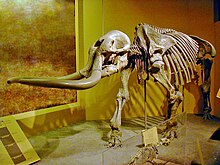Stegomastodon
| Stegomastodon | |
|---|---|

| |
| S. mirificus fossil at the Smithsonian Natural History Museum | |
Fossil
| |
| Scientific classification | |
| Kingdom: | |
| Phylum: | |
| Class: | |
| Order: | |
| Family: | |
| Genus: | †Stegomastodon Pohlig, 1912
|
| Species | |
| |
Stegomastodon ('roof breast tooth') is an extinct genus of gomphothere, a family of proboscideans. It is not to be confused with the genus Mammut from a different proboscidean family, whose members are commonly called "mastodons", nor with the genus Stegodon, from yet another proboscidean subfamily, whose members are commonly called "stegodonts". The Stegomastodon was one of the smaller species through the genus. It ranged through North and possibly South America.
Species
The following definite species have been described:[1]
- S. aftoniae
- S. mirificus
- S. nebrascensis
- S. primitivus
S. waringi is considered synonymous with S. platensis. There is currently a dispute over whether S. platensis should remain within the North and Central American genus Stegomastodon or should be moved over to the exclusively South American genus Notiomastodon.[2][3] The genus Haplomastodon is regarded as synonymous with the South American Stegomastodon species.[4][5]
Distribution
The South American Stegomastodon fossils could be reassigned to Notiomastodon. Still, in paleontological literature, the genus and species name are used, until in 2016.[6]
Description


Stegomastodon mirificus is known from NMNH 10707, an approximately 30-year-old male, of which most of the skeleton has been found. Alive, it stood approximately 2.6 metres (8.5 ft) tall, with a weight around 4.7 tonnes (4.6 long tons; 5.2 short tons).[7] Like modern elephants, but unlike most of its closer relatives, it had just two tusks. These tusks curved upward and were about 3.5 metres (11.5 ft) long. Stegomastodon's molars were covered in enamel and had a complex pattern of ridges and knobbly protrusions on them, giving the creature a large chewing surface that enabled it to eat grass. Its brain weighed about 11 pounds (5 kg).
The genus lived in North America from the Zanclean of the Pliocene to the Late Pleistocene. The most recent specimens in the fossil record originate from Jalisco, Mexico, and date to 28,000 BP.[8]
Taxonomy
Revised taxonomy of Stegomastodon and other trilophodont gomphotheres according to Mothé et al., 2016:[9]
†Gomphotheriidae (Gomphotheres)
|
| ||||||||||||||||||||||||
References
- ^ Stegomastodon at Fossilworks.org
- ^ Labarca, R.; Alberdi, M.T.; Prado, J.L.; Mansilla, P.; Mourgues, F.A. (18 April 2016). "Nuevas evidencias acerca de la presencia de Stegomastodon platensis Ameghino, 1888, Proboscidea: Gomphotheriidae, en el Pleistoceno tardío de Chile central/New evidences on the presence of Stegomastodon platensis Ameghino, 1888, Proboscidea: Gomphotheriidae, in the Late Pleistocene of Central Chile". Estudios Geológicos. 72.
- ^ Mothé, Dimila; dos Santos Avilla, Leonardo; Asevedo, Lidiane; Borges-Silva, Leon; Rosas, Mariane; Labarca-Encina, Rafael; Souberlich, Ricardo; Soibelzon, Esteban; Roman-Carrion, José Luis; Ríos, Sergio D.; Rincon, Ascanio D.; Cardoso de Oliveira, Gina; Pereira Lopes, Renato (30 September 2016). "Sixty years after 'The mastodonts of Brazil': The state of the art of South American proboscideans (Proboscidea, Gomphotheriidae)". Quaternary International. doi:10.1016/j.quaint.2016.08.028. Retrieved 4 May 2017.
- ^ Lucas, Spencer G.; Yuan, Wang; Min, Liu (2013-01-01). "The palaeobiogeography of South American gomphotheres". Journal of Palaeogeography. 2 (1): 19–40. doi:10.3724/SP.J.1261.2013.00015.
- ^ Dantas, Mário André Trindade; Xavier, Márcia Cristina Teles; França, Lucas de Melo; Cozzuol, Mario Alberto; Ribeiro, Adauto de Souza; Figueiredo, Ana Maria Graciano; Kinoshita, Angela; Baffa, Oswaldo (2013-12-13). "A review of the time scale and potential geographic distribution of Notiomastodon platensis (Ameghino, 1888) in the late Pleistocene of South America" (PDF). Quaternary International. Quaternary in South America: recent research initiatives. 317: 73–79. doi:10.1016/j.quaint.2013.06.031.
- ^ Labarca, Rafael; Alberdi, María Teresa; Prado, José Luis; Mansilla, P.; Mourgues, F.A. (2016). "Nuevas evidencias acerca de la presencia de Stegomastodon platensis Ameghino, 1888, Proboscidea: Gomphotheriidae, en el Pleistoceno tardío de Chile central". Estudios Geológicos. 72: e046. doi:10.3989/egeol.42199.385. Retrieved 2017-05-07.
- ^ Larramendi, A. (2016). "Shoulder height, body mass and shape of proboscideans" (PDF). Acta Palaeontologica Polonica. 61. doi:10.4202/app.00136.2014.
- ^ Alberdi, María Teresa; Juárez-Woo, Javier; Polaco, Oscar J.; Arroyo-Cabrales, Joaquín (2009-02-01). "Description of the most complete skeleton of Stegomastodon (Mammalia, Gomphotheriidae) recorded for the Mexican Late Pleistocene". Neues Jahrbuch für Geologie und Paläontologie, Abhandlungen. 251 (2): 239–255. doi:10.1127/0077-7749/2009/0251-0239.
- ^ Mothé, Dimila; Ferretti, Marco P.; Avilla, Leonardo S. (12 January 2016). "The Dance of Tusks: Rediscovery of Lower Incisors in the Pan-American Proboscidean Cuvieronius hyodon Revises Incisor Evolution in Elephantimorpha". PLOS ONE. 11: e0147009. doi:10.1371/journal.pone.0147009.
{{cite journal}}: CS1 maint: unflagged free DOI (link)



